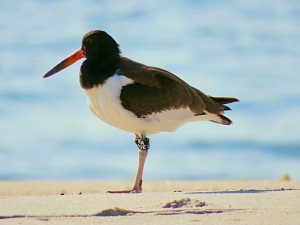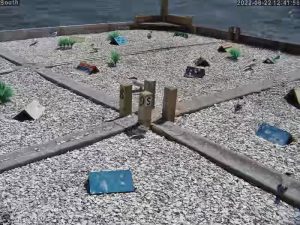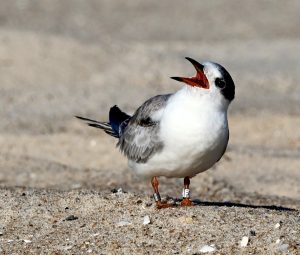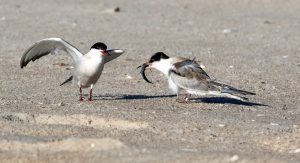
If you recall, the American Oystercatcher chick that has fledged in July, or at least we hoped fledged in July, was spotted on Assateague and is alive and looking healthy!
Unfortunately, none of the last Common Tern nests successfully hatched any chicks. Generally, late nests are unsuccessful because they are made by young inexperienced terns, who may not have figured everything out yet. So, now there are not any terns left incubating eggs and the terns remaining on the raft are busy feeding their chicks, which is normal for this time of year. The tern chicks that successfully fledged and their parents continue to return to the raft at night to roost. Here is a picture of the raft at night and the same view during the day taken from the cameras on the raft. Notice the dramatic different number of terns.
Photo by Molly Struble (National Park Service)


There are still chicks running around the raft, learning to use their wings and growing bigger and stronger every day. By the end of next week, the youngest chick on the raft should be ready to fledge! It will remain on the raft for a couple of weeks after that date though, as the parents will continue to feed it. Although the chicks are considered “fledged” when they can fly, they only fly short distances and still remain in the colony to build up wing strength. They migrate anywhere from Florida to Argentina for the winter, so their wings need to be strong enough to make the long journey.
Once the fledglings disperse from the raft and the nesting colony, where do they go? The fledglings stay with their parents and continue being fed for at least 3-4 weeks. Some of the fledglings were spotted being fed by their parents on Assateague, right in a Least Tern colony! In fact, the adult Common Tern were not just seeking out other terns to associate with-they were stealing fish from smaller Least Terns! As the Least Terns were returning with fish for their own chicks, Common Terns would swoop in and dip and chase until they could get the Least Tern to drop the fish and they would catch it mid-air. This is called kleptoparasitism or aerial piracy and quite a few different tern species do it, as well as gulls. Terns steal from other tern species and from other individuals from their own colony.
-Dr. Archer Larned
-Photos by Coastal Bird Conservation Specialist Kim Abplanalp



